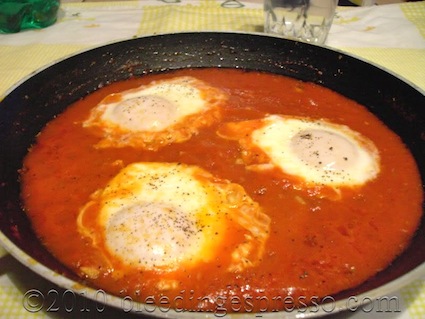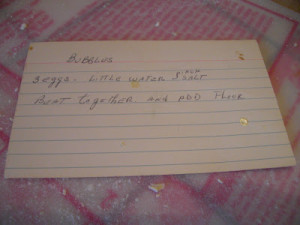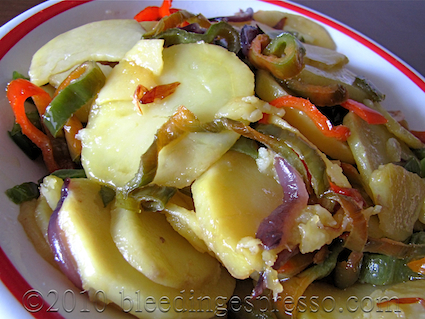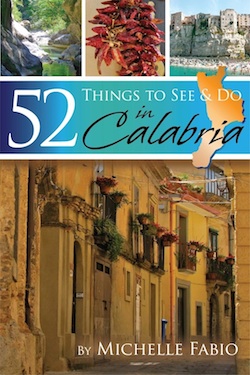Archive for the ‘what’s cooking wednesday’ Category
Recipe: Eggs in Purgatory – Uova in Purgatorio
Because of this dish, I’ll probably get a few hits from freaky religious people searching for their paths or their Truth or whatever, but so be it. Eggs in purgatory are gooood.
Besides, I’ve recently been found by someone searching for “the ledge freaky weird stevie fans stevie nicks,” so I shouldn’t so much worry about the religious nuts, right?
Welcome freaky religious people!
Today’s What’s Cooking Wednesday is inspired by the fact that P brings me at least 5 eggs every day.
We have hens you know. Although we give most of the eggs away, there’s still an awful lot left over. And that allows one’s imagination to run wild with visions of different egg plates.
And someday I’ll show you the hens, I promise.
I remember my grandmother serving Eggs in Purgatory (which I’ve also seen called “uova fra diavolo“) as a quick, light lunch or dinner — kind of something you make when you don’t know what else to eat. But it could easily be an impressive looking appetizer for those who don’t know just how easy the recipe really is.
As far as I know, this dish comes from Naples — if The Sopranos Family Cookbook says so, it must be true. Actually though, I assume my grandmother got this one from her father’s side of the family, which was from a small village in the province of Salerno near Naples called Pisciotta. According to family lore, her father was also quite a cook, particularly with coniglio (rabbit).
If you already have leftover tomato sauce, by all means, just put that in a skillet and heat it up before breaking the eggs in. That makes this recipe *extremely* fast and easy.
For those who are doing this from scratch, though, I’ll include a recipe for sauce here, which happens to be a basic pizza sauce. The oregano is what makes this fabulous, IMHO.
Uova in Purgatorio/Eggs in Purgatory
(serves up to 4)
- 2 tablespoons olive oil
- 1 clove garlic, finely chopped
- 1 can peeled tomatoes, passed through grinder, or coarsely chopped
- 1/4 teaspoon dried oregano
- Salt, black pepper, & peperoncino to taste
- 1-2 eggs per person (up to eight)
- Freshly grated Parmigiano Reggiano cheese
1. Put the olive oil in a skillet large enough to hold the number of eggs you’ll be making.
2. Sauté the garlic until over medium heat but don’t let it burn.
3. Add the tomatoes, oregano, salt, pepper, and peperoncino and cook sauce for about 15 minutes or until it is thickened to your taste.
4. Once the sauce is ready, make little wells in the sauce and break in eggs one at a time. Grate a generous amount of Parmigiano Reggiano cheese directly on top.
5. Cover the skillet and let eggs cook until the yolks are to your desired runnyness (yes, that’s a word for the purposes of this recipe).
6. Serve immediately with crusty bread. Grate more cheese on top if you like ’em cheesy like I do!
Buon appetito!
What’s Cooking Wednesday: Linguine agli Scampi
Last week I teased your tastebuds by suggesting that maybe P’s linguine agli scampi would be this week’s What’s Cooking Wednesday featured dish.
And here we are.
This is a very easy recipe and looks pretty classy when it’s all finished too–as well it should for the price of prawns these days. And probably all days, but I only know about these, so I’m limiting the generalization.
Linguine agli scampi (Linguine with prawns)
(serves 4-6)
- 3 tablespoons olive oil
- 6 whole, peeled cloves garlic
- 8 cherry tomatoes
- 20 prawns
- 1/4 cup white wine
- 1 1/2 tablespoons parsley
- 1/4 teaspoon salt
- peperoncino to taste
- linguine
- salted water to boil linguine
1. As this sauce only takes about a half hour from start to finish, go ahead and put your water on for the linguine before you start doing anything else. Wash and cut tomatoes in half and put aside.
2. Put the olive oil in a pan on medium heat and sauté garlic until just turning light golden brown.
3. Now here it gets a little complicated. Put everything else in the pan. Yes, add the tomatoes, prawns, wine, salt, peperoncino, and most of the parsley (save some to garnish).
4. Cover and let simmer for about 20-30 minutes.
As you can see, we cook the prawns as they are, heads and all. If you’d rather shell them first, by all means, snap off their heads, devein if you must (shouldn’t that really be a hyphenated word?), and get on with it. The recipe is still going to go pretty much the same, but be careful not to overcook the fish (thereby completely losing your prawns in the sauce).
5. So while the sauce is just about ready, drop your linguine in the boiling water and cook till al dente. In the meantime, take the prawns from the pan and put aside. When the linguine is done, add it to the pan (the sauce will be thin) and mix well.
6. Serve each dish with a few prawns and fresh parsley on top.
Buon appetito!
What’s Cooking Wednesday: Italian Wedding Soup
Wedding soup is an important, delicious Christmas tradition in my family, and even though P had never even heard of it, I made it this year as part of our Christmas festivities.
This soup has kind of an interesting history, I think, in that although many Italian-Americans know it, it’s not well-known in many parts of Italy. I’ve read that its origins are in the south (not surprising as so are those of many Italian-Americans!), particularly in Campania (the region of Naples), and that it’s name comes from the fact that the ingredients “marry well” as the Italians say . . . si sposano bene. In southern dialect this becomes “minestra maritata,” or wedding soup.
Be forewarned: from start to finish, it was a 3 and a half hour (fun-filled) journey.
My grandmother’s version of Italian wedding soup is with escarole, mini-meatballs, pasta “bubbles,” and egg drop on top, and it is so time-consuming it’s usually made only for special occasions like Christmas and Easter. Trust me, though, every minute of toiling over a hot stove is *so* worth it.
A few days ago was the first time I’ve ever made it by myself so indulge me while I give myself a big ole’ pat on the back. I tried to pay special attention to the amounts of ingredients, because all that was passed down to me were basic guidelines (see my grandmother’s original recipe for the pasta “bubbles” below). Incidentally, I’ve never seen another recipe that adds these “bubbles,” as my grandmother called them, but they do add a lot to the soup (and personal satisfaction for a job well done).
Italian Wedding Soup
(serves 8-10)
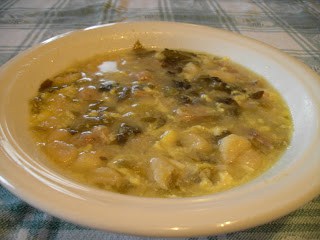
For the broth:
1 three to four lb. chicken
Enough cold water to cover the chicken and to boil escarole
1 lb. escarole, chopped coarsely
3 stalks celery
3 white onions
2 teaspoons salt
ground black pepper to taste
For the mini-meatballs:
1/2 lb ground veal
1/2 lb ground pork
1/4 cup breadcrumbs
1 egg
1 tablespoon parsley
2 teaspoons onion powder
1 teaspoon garlic powder
2 tablespoons grated Pecorino Romano cheese
1 teaspoon salt
1 tablespoon vegetable oil (for frying)
For the bubbles:
3 eggs
1/4 cup cold water
pinch salt
3 cups flour
1 tablespoon vegetable oil (for frying)
or as my grandmother wrote:
4 eggs
2 tablespoons grated Pecorino Romano cheese
pinch salt
1. Take the chicken (an old hen if possible) and put it in a large stock pot, covering it with cold water. Cook on medium to high heat for about an hour and a half, skimming off any white foam that surfaces.
2. At the same time, put the coarsely chopped escarole in salted water and, as my mother says, “boil the hell out of it.” Seriously, you’re not going to overcook this, so just let it cook until you’re ready to throw in into the broth.
3. In the meantime, mix together all of the meatball ingredients and make little 1/2 inch balls–about the size of a marble is what we’re looking for. Put these aside.
4. For the bubbles, beat together the egg, water, and salt, and then add the flour until you get a thick dough. If it’s sticky, add more flour. Take off chunks of the dough and make into little snakes, and then cut off 1/4 inch pieces on an angle. Keep the bubbles separated from one another by using lots of flour; they are happier this way.
5. Also in the time the chicken and escarole are cooking, clean the celery and onion. No need to chop, as you’ll be putting them in the broth whole and then taking out their biggest remaining chunks later.
6. Now you’re ready to fry the bubbles. Put a tablespoon of vegetable oil in a frying pan set to high heat. Add as many bubbles as comfortably fit. Once they are a light golden brown color all around, remove them and put on paper towels to absorb excess oil.
7. Fry the meatballs in the same way, browning the surface, or, if you like, you can add them directly to the broth when you add the escarole and fried bubbles.
8. Once the chicken is cooked, remove it from the water and let cool. Add the celery, onions, salt, and pepper to the broth, and let cook for another half hour or until you start to see that the vegetables are getting mushy. You’ll want to take out the biggest chunks, but if you like, take some of the mushiest and chop them very finely to throw back in.
9. In the meantime, clean off the chicken and put the meat back into pot, discarding bones and skin.
10. After you’ve removed the celery and onion chunks, drain the escarole and add to the broth. Also add the bubbles and meatballs. This mixture needs to cook for another half hour or so (possibly longer if you didn’t fry the meatballs). The bubbles shouldn’t be chewy but rather al dente, like any good pasta, and the meatballs should have no pink left.
11. Now we’re ready for the finishing touch: the egg drop on top. While bringing the soup to a boil, in a separate bowl, beat the egg, cheese, and salt together. Once the soup is boiling, drizzle the egg mixture over the top of soup, swirling with a fork while the egg sets. Once the eggs are cooked, your wedding soup is ready.
12. You can serve with fresh grated Pecorino if you particularly love this cheesy flavor as I do.
13. My grandmother also threw in a pasta called “Acine di Pepe,” (àh-chin-ay dee péh peh) but, um, I couldn’t find it. In Italy. Go figure.
And actually, a quick Google tells me that it’s fairly popular in something called Frog Eye Salad (anyone ever made this?) and that the Acine isn’t necessarily easy to find in every part of America either. From personal experience, if you happen to be in Northeastern/Central PA, though, you should be fine.
Anyway, any small soup pasta will do, but this time around I let the bubbles speak for themselves, and the soup was as delicious as I remembered.
Final Tips:
If you didn’t add the bubbles, or want to add soup pasta too, cook the pasta separately, and keep separate. When serving, put the desired amount of pasta in a bowl and then put the soup on top. If you leave the pasta in the soup, the bits get really bloated, and no one’s happy bloated.
On the same note, if you’re storing leftover soup, take out the bubbles and keep them separate in the refrigerator as well; they, too, will suck up your hard-earned broth. This is assuming your pot will fit in the fridge. If you live in a climate like where I grew up, you can do like we did and keep the pot of soup on the porch for natural refrigeration–just make sure it’s actually cold enough to do so.
Because, you know, rancid wedding soup isn’t really, how you say, enjoyable.
Buon appetito!
What’s Cooking Wednesday: Calabrian Stuffed Lasagne
This stuffed lasagne from Calabria is made with a tomato-based meat sauce and includes hard-boiled egg, ham, and cheese. Stuffed with goodness!
Read on...What’s Cooking Wednesday: Potatoes and Peppers
And onions too, if you want to be particular.
P’s mom brought me some gorgeous peppers, so today we’re doing a side dish that’s good enough to eat as a whole meal–and it’s easy as all get out. Six ingredients. Olive oil, potatoes, green and red peppers, onions, salt, and peperoncino. That’s it. You can also use yellow peppers, by the way; you’ll have a sweeter overall taste.
But before we get to the recipe, a note on the peperoncino (chili pepper) for the uninitiated. As I was cooking, I realized that I put peperoncino in everything–I’m fairly certain this is the law in Calabria.
Those who don’t like spicy food might be afraid of this lil’ devil , but don’t be! If you add just a dash, it will heighten all of the other flavors. Add too much and you might be calling the Vigili del Fuoco, but just take it slowly at first, and you’ll be fine.
Potatoes, Peppers & Onions
(serves 4)
- 6 medium sized potatoes
- 2 large red bell peppers
- 2 large green peppers
- 1 medium onion
- 5 tablespoons olive oil
- salt to taste
- peperoncino to taste
1. Peel and thinly slice the potatoes. Keep them in a bowl of fresh water until you are ready to cook them.
2. Wash and slice the peppers into thin strips.
3. Peel and slice onion into strips as well.
4. Put 2 1/2 tablespoons of olive oil in a large pan and turn heat on to medium. Sauté the onions until they are translucent, about 3 to 4 minutes.
5. Remove them, leaving behind as much oil as possible, and put potatoes in pan. Coat the potatoes in the remaining oil and cook for about 10 to 15 minutes, or until the potatoes are cooked through and slightly brown. Be sure to move the taters around a bit or they’ll burn and or/stick on the bottom.
6. Remove the potatoes.
7. Add another 2 1/2 tablespoons of olive oil to the pan. Put in the peppers, stirring to coat them in the olive oil, and sauté for about 10 minutes or until they are almost fully cooked to the consistency you like. They won’t cook all that much more once you throw everything in together.
8. Put the potatoes and onions back into the pan, add salt and peperoncino/pepper, and mix well. Lower the heat and cook for another 10 to 15 minutes, or until everything is cooked to your satisfaction. Be sure to stir occasionally..
9. Serve hot with fresh Italian bread and/or as a side dish with sausage, chicken, and more.
Buon appetito!

